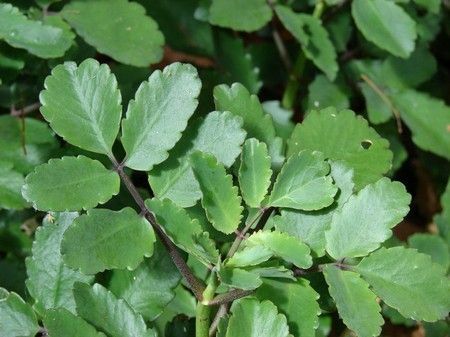We are used to treating indoor plants as interior decorations and, in rare cases, as an additional source of oxygen. And what about the fact that long-known domestic "green plantations" can be an excellent alternative to expensive drugs?

. In a situation where the runny nose was strong and threatened to pass( or has already passed!) To sinusitis, the Kalanchoe juice will come to the rescue, which will be several times cheaper than purchased medicines, but in terms of efficiency they will not give in to them at all.
What should I know about the Kalanchoe?
Visually this plant is known to many. There are both wild species of the species, and domestic. We are interested in the second variant, which differs from its "wild" fellow by more significant dimensions. The average height of this succulent growing in the houses is about 120 cm, the width of the fleshy leaves, from which the juice is extracted - about 10 cm.
Before starting the treatment, it is worthwhile to learn that from the whole variety of species of this plant is really useful inThere are only two cures for getting rid of a cold:
- pinnate calanchoe( in Latin its name is written Kalanchoepinnata);
- calanchoehedegremona( in other words, Kalanchoedaigremontiana).
The remaining succulents of this family are most likely not to cause harm, but there will not be much benefit from them.

Is the juice of this plant safe for treatment?
Given the fact that the drugstore sells Kalanchoe juice, packaged in different containers, we can say that the official medicine recognizes this medicine.
Research conducted at the Research Institute of Epidemiology, Microbiology and Parasitology. LV Gromashevsky( Kiev, Ukraine), confirmed the effectiveness and safety of the facility. But! The experiments were performed with a pinnate variety.
Caution! In some sources( mostly foreign), one can find references to the fact that the plant can be poisoned if consumed as food. Therefore, it is worth refraining from such a "dish".
What is the therapeutic effect on and what microorganisms are affected by plant juice?
As a result of a laboratory study of Kalanchoe, it was found that the juice contains such substances:
- organic acids;
- enzymes, lectins;
- flavonoids;
- bufadienolides;
- microelements( magnesium, calcium, etc.);
- tannins.
Unfortunately, it is not known which of these components makes the use of Kalanchoe juice so effective, but in the treatment of Staphylococcus aureus, streptococci, influenza virus, this drug has been used for a long time and successfully.
Recommendation! Otitis, sinusitis, tonsillitis, sinusitis - just what can be cured with this tool.
Let's move on to the practice of
The theoretical part is now known to you. It's time for practice! The first step is to figure out how to extract the juice from the plant to use the calanchoe in the event of a runny nose.
- Before squeezing the juice, the plant is recommended to be placed in a dark and quite cool room for a week.
- After the preparation time has elapsed, large leaves are cut off from the stem.
- They are thoroughly washed and then ground into a gruel( the best thing to do is a wooden spoon).
- Using gauze, the resulting mixture is filtered and the resulting pure Kalanchoe juice is poured into a prepared container( ideal if it is sterile and made of glass).
Specification! Store the juice should be at a temperature of no more than 10 degrees Celsius( in the dark).
How to cure a runny nose using a plant juice
If you are concerned about a runny nose of one or another intensity, it is advisable to use the remedy in such variants:
- combination of Kalanchoe juice and onion juice( they are mixed in 1: 3 ratio, ie 1 part onion juice, 3parts of the Kalanchoe juice);
- Kalanchoe and aloe juice( mixed in equal parts);
- mixture with milk or boiled water( connect the liquid in a 1: 1 ratio).
How to use the medicine for sinusitis?
In the case when you were diagnosed with "genyantritis" in a hospital or polyclinic, you should not hesitate. Of course, traditional medicine can not replace this medicine, but as an auxiliary preparation of Kalanchoe juice for sinusitis, doctors prescribe quite willingly, taking into account the above mentioned therapeutic properties.

To get rid of the maxillary sinusitis as soon as possible, it is necessary to combine the juice of Kalanchoe with alcohol. The proportion is 20: 1( that is, 20 drops of plant juice and 1 drop of alcohol).
Important! You can store the medicine for about a year.
How to use?
Prepared medications can be used in many ways:
- endonasal lotions( a tampon moistened with juice is placed inside the nose);
- instillation( 3-4 drops in one nasal passage);
- electrophoresis.
Tip! As a rule, lotions or drops are applied three times a day. For electrophoresis, juice is better to use, after consulting with a doctor.
And what about the children?
Young children also suffer from a common cold quite often. And more and more often parents refuse pharmacy drops in favor of cooked houses. Juice of Kalanchoe from the common cold to children is quite an appropriate decision. Just remember that its use is better coordinated with the pediatrician, and in the process of using to closely monitor the patient's condition. How to know if a child has an individual intolerance to this plant?

with a cold! Advice of the doctor! In order not to provoke deterioration, pediatricians advise using this succulent juice not earlier than the third day after the appearance of the common cold.
In any case, this method of treatment is preferable to the unjustifiably frequent use of vasoconstrictor drops.
Recipe for children can be as follows: broth( several medium-sized sheets are poured in cool water( about ½ cup), and then boil for about 1 minute, after which the broth is infused for 60 minutes);Bury 1-2 drops in each nasal passage 2-3 times a day.
Important! Breastfeeding, that is, children under one year are best not to use such treatment option or do it after the doctor's clear approval.
Good health to you and your loved ones!
